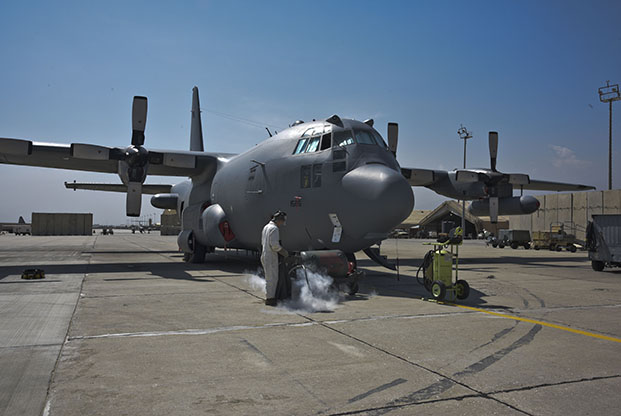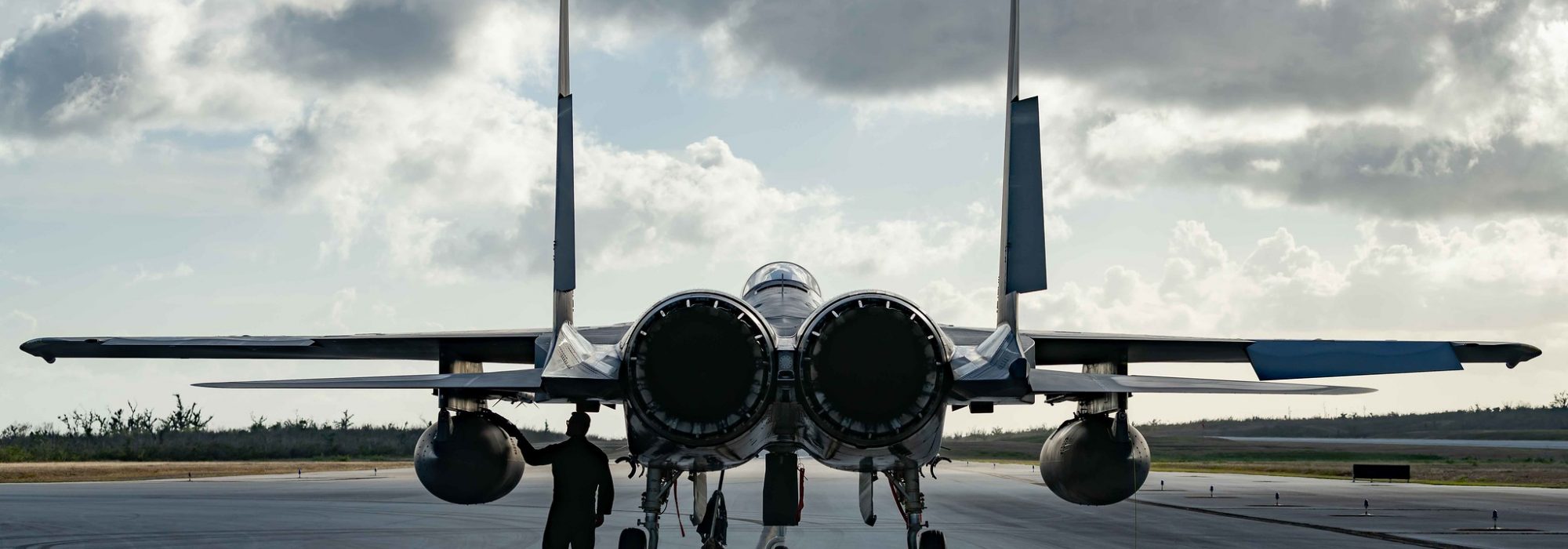
An airman runs maintenance on an EC-130H Compass Call at Bagram Airfield, Afghanistan, in 2018. The Compass Call mission is transitioning to the new EC-37 airframe. Photo: SSgt. Kristin High
REBUILDING ELECTRONIC WARFARE
After long years of neglect, the Air Force plans to reorganize its chaotic electronic warfare enterprise, creating a new service EW czar to coordinate its efforts in the domain, and breathing new life into the career field specializing in warfare in the electromagnetic spectrum.
The action plan will create an electromagnetic spectrum (EMS) “champion” on the Air Staff, who will advocate for the mission and its practitioners and consolidate USAF’s disparate EW tools and missions—everything from jamming pods and decoys to dedicated EW aircraft—into a coherent and rationalized enterprise.
The plan came out of a yearlong Enterprise Capabilities Collaboration Team (ECCT) review of USAF’s electronic warfare tools and tradecraft, which was headed up by Brig. Gen. David M. Gaedecke, USAF’s director of cyberspace operations and warfighting integration, and approved in April by Chief of Staff Gen. David L. Goldfein.
Electronic warfare is essential to each of USAF’s core competencies, Gaedecke said in a press release. These moves will help USAF “maintain our competitive advantage in [the] EMS to achieve freedom of action while denying the adversary that same freedom of action.”
The new EW czar, a general officer not yet named, will head the EMS Superiority Directorate, managing a portfolio of EMS priorities and investments such as the Eagle Passive/Active Warning Survivability System (EPAWSS) electronic warfare suite for the F-15 Eagle; the Miniature Air-Launched Decoy and its jamming variant; defensive EW pods for fighters, defensive and offensive electronic systems on bombers; and large systems such as the EC-130H Compass Call electronic warfare aircraft, which is transitioning to the new EC-37 airframe. It could also include advanced radar systems that have evolved beyond detection and tracking and that have an inherent ability to hop frequencies and pump focused electrons in many directions.
What’s not clear is whether the new directorate will be in charge of things like Sniper and Litening pods, or the F-35’s Electro-Optical Targeting System, given that those systems operate in the visual and infrared parts of the spectrum. Service officials say IR systems will increasingly be fused with radio frequency sensors as adversary aircraft become stealthier and multi-sensor search and tracking becomes standard.
LOST FOCUS
Gen. James M. Holmes, head of Air Combat Command, said, “15 years squared off against violent extremists” in Afghanistan and Iraq has had an impact on the Air Force’s EW expertise. The service suffered, “a loss of focus on coordinating our electronic combat tools,” he said in an interview. Now, that focus is back. “You’ll see us with a renewed focus in dominating that electronic spectrum,” he said. The refocus on EW practitioners will allow USAF to come up with new concepts and new presentations.
Because the ECCT review is classified, Holmes and others remain purposely vague about its findings. But the National Defense Strategy is clear about the threat, noting that Russia and China have leaped forward in the past two decades, and critics complain the ECCT did not go far enough and failed to codify a servicewide plan for electronic attack.
USAF also struggles with definitions in the electromagnetic field and with uncertainty about where cyber operations end and EW begins. That’s one reason the 24th and 25th Air Forces will merge this summer into a new numbered Air Force, combining cyber with intelligence, surveillance, and reconnaissance activities.
Holmes said the new plan will focus on EW planning and “how to integrate it against a peer adversary.”
Muddy Watters, president of the Association of Old Crows—an organization of past and present electronic warfare practitioners—said in a statement that the ECCT’s recommended actions “should ignite a resurgence in the Air Force EW and EMS capabilities.” Putting a general officer in charge of the new EMS directorate should help USAF regain the “high ground” after US capabilities atrophied in the wake of the Cold War.
The new directorate will help the Air Force identify gaps in its capabilities, field critical technologies more quickly, and “ultimately facilitate the equipping of tomorrow’s warfighter,” Watters said.
CHINA: THE 30 YEARS WAR
China plans to match the US as a world military and economic power within 30 years and is moving deliberately toward achieving that goal, the Pentagon said in its annual report on China’s military capabilities. Noteworthy developments highlighted by this year’s report include:
- The nearing deployment of a Chinese nuclear deterrence triad, like that possessed by the US and Russia.
- An aggressive program of building new military bases abroad.
- The construction of China’s third large aircraft carrier.
- Chinese efforts to stake its claim as a “near-Arctic” nation with claims on that region’s resources.
“China has a stated goal of becoming a world-class military by 2049,” said Randall G. Schriver, assistant defense secretary for Indo-Pacific Security Affairs. Briefing reporters in early May on the annual report, “Military and Security Developments Involving the People’s Republic of China 2019,” Schriver said China aims to “erode US military advantages and seeks to gain and maintain influence. And it backs these ambitions with significant resourcing, which translates into real capabilities and capacity.” China’s defense budget continues to grow at “near double-digit” percentages, the report noted.
Schriver said China has “areas of excellence” in its capabilities to build ballistic and cruise missiles, and it is deploying increasingly sophisticated ballistic missile submarines. It is both expanding its fleet of older-style bombers and developing new ones, which the report said are likely to have some low-observable capability and become available in the mid-2020s. That is about the time the US expects to begin fielding its new B-21 bomber.
Will China soon have its own nuclear triad? Schriver might not use those words, he said, but the Chinese are “heading in that direction.” Where China is still lacking is in doctrine and training, he said. The bulk of China’s nuclear weapons are still mounted on intermediate-range missiles. It is unclear how quickly China could achieve a full triad capability.
Schriver said China is not an enemy, but a competitor, noting the US competes with China economically and in the battle for influence and does not see armed conflict with China as inevitable. The US National Defense Strategy requires that the US compete “from a position of strength,” he said, “while encouraging China to cooperate with the United States on security issues where our interests align.”
That contrasts with China’s strategy and objective, which Schriver said is to “supplant the United States and become the pre-eminent power in the Indo-Pacific.”
The report points out that China’s third and newest aircraft carrier is of domestic design, unlike the previous two, which were of Russian design. Both of those vessels use the “ski jump” launch system, which limits the number of aircraft that can be carried. The new carrier, though, will be larger and use a catapult system like US carriers. That means more aircraft on deck and more rapid flight operations. The report anticipates it to be deployed around 2022.
Schriver said China has developed and deployed a new class of guided missile cruisers—the “Renhai” class, which will be its “premier carrier escort for blue-water operations, carrying an array of long-range, anti-ship missiles.”
China’s fifth-generation J-20 stealth fighter, which Schriver said will be operational this year, will join a mostly fourth-generation force. The report also notes that China has tested a hypersonic cruise missile.
To go with the new equipment, Schriver said China has put greater emphasis on “realistic and joint training across all warfare domains.”
China is actively looking to set up military bases across the world, often tying access to economic development deals with the host country. New Chinese bases are spouting up—or soon will be—in the Middle East, Southeast Asia, and the Western Pacific, Schriver said. A number of these are associated with China’s “One Belt, One Road” plan for connecting the Eurasian continent with a series of rail and highway connections and the “Made in China 2025” initiative to corner the market on certain industries.
TAIWAN ON
China continues to try to achieve its ends without conflict, using “persuasion and coercion,” the report noted, and is attempting to isolate Taiwan with economic pressure on small nations to withdraw their recognition of Taiwan. China also continues to “undermine democracy in Taiwan by meddling in its elections,” Schriver reported. He said the US is pledged to supply Taiwan with the means to defend itself, but he stopped short of saying the US would come to Taiwan’s defense if attacked.
“Our law says that any threat to Taiwan—and it’s a broad definition of a threat, to include economic threats, blockade, etc.—would be regarded with grave concern in the United States,” Schriver said, adding that in such an event, the president would “consult with Congress on an appropriate response.” In previous cases, the US has “responded in an appropriate manner to help support Taiwan.”
The report also offers a special examination of China’s plans and policies regarding the Arctic, given China’s declaration that it is a “near-Arctic state.” It already has one large icebreaker and is building others, Schriver noted, and has also “announced a polar silk road.” China is looking for access to potential resources on the Arctic sea floor and shipping routes, according to the report, and may be eyeing the region as a place it would deploy ballistic missile submarines, Schriver said.
China’s use of cyber for intelligence collection is a “persistent” challenge, he said, and the main change in this area is “our level of awareness and the steps we’re taking to reduce our own vulnerabilities.”
